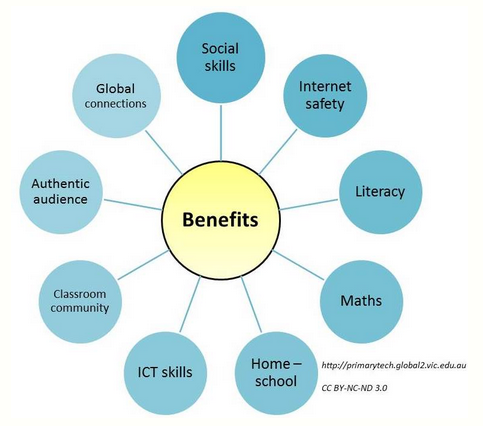

Rationale
When students write a paper, hand it to the teacher and then get it handed back to them, they call it "playing school." When they're writing a blog, they're communicating. David Warrick
Being a blogger is about what young people do when they sit down to work at their computers. It is about creating a space in their lives to safely extend and explore their online voices with a group of peers, both at school, in another part of town, in another state, and around the world. Paul Allison
Food for Thought
- How does sharing, revising and publishing happen in twenty-first-century writing workshop? In blogs.
- "Blogging is not the same as traditional writing in that blogging
invites writers to synthesize ideas and opens up conversations between
writers through commenting on the posts of others and then
incorporating those posts into one's own writing." (Will Richardson)
- When used as a writer's notebook, a blog allows students the
opportunity to live what Calkins calls their "writerly lives" online,
sharing their initial ideas with others and opening them up for
feedback.
- When students participate in "affinity spaces" they are contributing to the "collective intelligence", turning the Web into a global brain... O'Reilly
What is the Pedagogical Potential of Blogs?
-
Challenges teachers and students to think about writing in authentic ways
-
Precise economical writing
-
Regular and timely responses
-
Engage people in knowledge sharing, reflection, and debate
-
Capture and disseminate student and faculty generated content
-
SupportBlogging - wiki set up to help promote an understanding of the benefits of educational blogging.


Implementation
You can get a Google Docs copy of A Mostly Complete Guide to Classroom Blogging right here. www.freetech4teachers.com
A Microblogging Lesson Idea and Template You Can Customize When it comes to creating for an audience, a series of short-form posts is super popular -- and I have a microblogging lesson idea.
10 Habits for Blogging
Blogging: The New Persuasive Essay
I think blogging is the new persuasive essay. If we’re trying to prepare our students to think critically and argue well, they need to be able to blog. It allows for interaction. It allows for ideas to be tested. And the best posts anywhere in cyberspace tend to have a point that can be argued. Read it here.
Blogging prompts for responses
_ Do you agree with this?
_ What do you
think?
_ Why do you think that?
_ How do you know?
_ Can you be
sure?
_ You may be surprised that I ...
Blogging Rules
- Social Networking and Security for Kids by Cindy Seibel
- A Proposal for Banning Pencils by Doug Johnson
- Responsible Blogging by C. Miller
- Blogger's Contract by David Warlick
- Discovery Blogging Rules
- Online Consent Form - Holicong Middle School
- 10 Tips for the Education Blogger
Additional Commenting Rules
- Consider strengths and weaknesses
- Start with strengths
- If you have something nice to say, say - and give specifics
- If you have criticism, say it nicely (Constructive criticism is helpful not vindictive)
Evaluating Blogs – Rubric
Six Assessment points for Student Blogs❶ How well did student writing address the curricular topic and/or
discussion theme?
❷ How well reasoned was the logic of what students wrote?
❸ How well developed was the writing?
❹ To what extent was their writing analytical about the topic?
❺ How well did they communicate their thinking?
❻ To what extent did their blog generate real discussion?
- Assignment Guidelines and Rubrics for Posts and Comments
- This rubric integrates more technical components of blogging: University of Wisconsin Stout. A Rubric for Evaluating Student Blogs.
- Blog Refection Rubric
- General Blogging Rubric
- Comprehension and Analysis Blog Rubric
- Research Blog Rubric
- Rubrics for Blogging and and Multimedia Projects .
-
Classroom Examples
- Terrific
resources for starting discussions and incorporating multimedia click
- Online student portfolios of filing cabinets where assignments or projects are stored
- Book Blogs: Online Interactive Literature Circles
Weblogs in Higher Education
The site includes pedagogical suggestions, as well as, blogs of interest.- Extending classroom time - continuing class discussions or posing questions for students to consider before coming to class. This gives quieter students the opportunity to participate. Students may also find this medium helpful as they have more time to formulate their thoughts.
- Participate in a debate as a social conversation involving competing perspectives without the physical intimdation of face3-to-face interactions.
- Cross-Cultural or International Exchanges
- Youth Wiki - schools
worldwide share experiences
- PolarHusky - Explorers write about journeys
- The Mixer - locate language partners
- Hands Across the World
- penpal service
-
Class portals where teachers keep homework assignments, links, handouts, syllabi, etc..
-
Collaborative writing spaces where students read and give feedback to one another
- Peer review
-
Reader's guides for literature study, newspapers, and project sites where students create and contribute all content
- Blog Booker BlogBooker allows
you to produce Pdf blog books from all your blog entries and comments.
These can be generated from any blog running on Wordpress, Livejournal
or Blogger. The whole process takes about 3 or 4 minutes. Once your
exported file is submitted the file is verified and then all your images
are linked and found and the whole thing is assembled as a book.This is great for teachers who regularly use blogs but for whatever reason need printouts. Not everyone is comfortable marking online or sometimes your Subject Co-ordinator requires evidence of learning. This is the answer.
- create an Online persona, e.g., historical figure or character
from literature
-
Post math problems and science related questions and have students explain why and how they solved it that way and then comment on their fellow students’ answers
- Building community - build a sense of community that that fosters learning and sharing ideas.
Blogging Host Sites
Chart Comparing Blogging Platforms Comparison of Six Blogging Services for Teachers outlines the administration options, design options, domain mapping options, and TOS conditions amongst other key features to look for when picking a blogging service to use in your classroom. You can get a Google Docs copy of the chart here and a PDF version here.
Show Your Students How Far Their Blogs Can Reach
- ClustrMaps is a free service that you can use to show students the global traffic sources of their blogs. ClustrMaps will display a real-time map of where in the world visitors are when they visit your blog. To get a ClustrMap for your blog just visit ClustrMaps.com, enter your blog's URL, and enter your email address. After your URL and email address are verified you will be able to get a ClustrMaps embed code to place anywhere on your blog.
- Blogger users have a built-in set of visitor statistics that will show you where your visitors are coming from. To access these statistics select "Stats" from the drop-down menu next to the name of your blog when you sign-in at Blogger.com. Video tutorial
Kidblog
Designed for elementary and middle school teachers who want to
provide each student with their own, unique blog. No need for student
email addresses. Kidblog Video Tutorials scroll down to middle of page Text Directions to set up | (New Kidblog Features tutorial video including using the Secret Code feature for creating a class)
Youngzine a source of news, sports, and entertainment stories for elementary school students. It also now offer a classroom blogs feature. Youngzine classroom blogs enable teachers to create a private online space for their students to use to discuss news stories. As a teacher you can register your students on Youngzine and assign them to your classroom. Then within your Youngzine classroom you can assign articles for your students to read, ask them to response to articles and discussion prompts, and view their scores on the Youngzine weekly quiz.
QuadBlogging is a free service that matches four classrooms together to follow and comment on blog posts. Register your class for QuadBlogging and you will be matched with three other similar classrooms. After being matched, it is up to you and the other teachers in your quad to continue the blogging relationship for as long as you would like. Learn more about the QuadBlogging concept in the video
ePals ePals offers a free blog to K12 educators worldwide. It got an award as "best blog for education" from Teaching & Learning Magazine in December 2006. When it's used with the Global Community and free student email, teachers have powerful ways to connect students to 21st century learning and to classrooms in 200 other countries and territories. Teachers can set different levels of monitoring, even for individual students. Teachers and students can make pages public, or limit blog views to particular audiences, including workgroups within a class. Students can upload files or photos, create polls, use a calendar. Having the "top level" public increases communication with parents.
Blogger
Good gateway
for novices. A Complete Guide to Using Blogger In School.
setup
instructions handout | Blogger Part 1 Blogger Part 2 | screencast tutorials | Blogger
Help channel on YouTube. | downloading blog | How to Limit access to Blogger Posts
Google has introduced their new feature for Blogger called "Google Scribe". click for review of options Google Scribe is text suggestions and auto complete feature, which can now be found in Blogger in Draft. Google
Scribe helps you write more efficiently by suggesting common words and
phrases as you type. Setting you should know: scheduling posts, moderate comments and adding multiple authors click hereHow to Add RSS Feeds and A Blog Roll to Your Blogger Blog
How to Enable or Disable Google+ Settings in Blogger
If you use Blogger and or your students use Blogger, you may have noticed that Blogger is now automatically posting to Google+ whenever you publish a new blog post. You can disable this feature in the Google+ menu on Blogger. In that same menu you can also enable or disable Google+ comments. The two screenshots below provide directions on how to enable or disable Google+ settings in Blogger.16 Add-ons to a Blog
NowComment - Turn any document into a class discussion with a commenting system that appears right next to the text. Watch the overview video at the site. Unlike traditional blogs this tool supports threaded discussions and juxtaposes a document next to the discussion board.
Quadblogging.net The site connects your class with three other classes from around the world and each class takes turns responding to one of the class's blog. A school will blog while the others view/comment and then rotate around while a educational moderator checks to make sure everything is running smoothly.
Wordpress
Simple and powerful WPBeginner offers free video and written tutorials for all of the basics and then some WordPress Manual | Creating | Video tutorial | downloading
Penzu Personal journal
Quickly Create Audio Messages for Your Blog
- SoundCloud is a great tool for creating short audio recordings. Those recordings can be embedded into blog posts. The feature of SoundCloud that makes it worth using instead of just embedding a recording from another service is that listeners can tie their comments to an exact moment in a SoundCloud recording. This means that if something twelve seconds into the recording triggers a thought in a students’ mind she can tie that comment to that exact moment
Vocaroo is a free service that allows users to create audio recordings without the need to install any software. You don't even have to create an account to use Vocaroo. All you need to provide is a microphone. To create a recording just go to Vocaroo.com, click record, grant Vocaroo access to your mic, and start talking. After completing your recording, Vocaroo gives you the choice to publish it or to scrap it and try again. Vocaroo provides the option to embed the recording anywhere.
- SpeakPipe is a tool that you can add to your blog to collect voice messages from blog visitors. The messages are automatically recorded and transcribed for you to listen to and or read. How to install SpeakPipe. following Video to explain how you can install SpeakPipe on a Google Site. www.freetech4teachers.com
- Audio Pal is a free service that allows you to quickly and easily record audio messages to post your blog or website. You can record your Audio Pal message by phone, through your computer's microphone, or by uploading a recording. Messages are limited to sixty seconds so you must be succinct. When you have a recording with which you're happy, enter your email address and an embed code will be sent to you almost immediately.
Web Doc - Multimedia Conversations Made Easy
ChatWing
is a free service that you can use to put a live chatbox into your blog
or website. The service actually creates a micro social network that you
can use in your blog - that's where the chatbox comes in - or as a
stand-alone service. When you sign up for ChatWing you're taken to a
screen to create your ChatWing network. On that same page you can
customize and test your chatbox. After you have settled on the design of
your chatbox you can grab the embed code to install ChatWing on your
blog or website.
How to Place an Image-based Quiz in Your Blog
How to Make Posts Sticky in WordPress, Kidblog, and Edublogs When you're using blogs in your classroom there may be some posts that you want to keep at the top of the page rather than letting them get pushed down by new entries. For example, if you're students are contributing to a group blog, you might want to keep the instructions post pinned to the top of the list of posts. Or you might want to keep a reminder about an upcoming due date posted at the top of the page.
Collaborize Your Classroom
Free online
discussion created for classrooms.| Good support for
classroom implementation | video
intro
Voice Thread
A collaborative multimedia slide show where
people can discuss and respond to images through text or voice. All
browser-based. VoiceThreads: Extending the Classroom with Interactive
Multimedia Albums article
with lesson ideas.
Posterous - a very simple publishing platform that works well for class blogging; Used online; Free
BlogBooker - Produces pdf blog book from your blog entries and comments.. Archives can be generated from WordPress, Blogger and LiveJournal
Articles
Blogging: The New Persuasive Essay Shelley Wright
I
think blogging is the new persuasive essay. If we’re trying to prepare
our students to think critically and argue well, they need to be able
to blog. It allows for interaction. It allows for ideas to be tested.
And the best posts anywhere in cyberspace tend to have a point that can
be argued. Read it here.
Online
Communities
The article discusses the
communication potential for blogs and podcasts.
Improving
Student Learning with Online Discussions
How to model and prepare students for online
discussions. Also some unique ideas for discussions.
HIgh Tech Reflection Strategies Make Learning Stick
To
Blog or Not to Blog
The pros and cons of blogging and podcasting with suggestions on
getting started in a classroom environment.
Instructional
Strategies for Blogging
While the notion of "finding individual voice" is not new to the
learning process, technology such as blogging has presented a unique
opportunity for teachers and students to work intentionally at this
process. The notion of individual voice, however, is difficult to manage
and evaluate. How individual is a comment? How personalized is the
voice of the student? Are students aware of a developing voice? Does
this voice raise the confidence of the student in the learning process?
Do students perceive the blogging process as helpful or just another
task/assignment?...